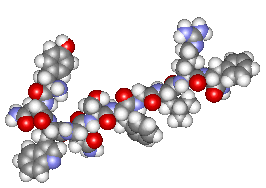 |
KisspeptinThe molecule of puberty |
 |
 |
KisspeptinThe molecule of puberty |
 |
![]()
Paul May
University of Bristol
![]()
Also available: HTML, Chime Enhanced and JMol versions.
![]()
 Surely nothing to do with Gene Simmons and Co.?
Surely nothing to do with Gene Simmons and Co.?No, not the rock band Kiss, although it has similarities it that it also sends teenagers wild. Kisspeptin is a protein that when released from the brain triggers the cascade of biochemical changes that leads to puberty, turning children into adults. Puberty is still one of the great unsolved mysteries in biology. Scientists have known for years that puberty begins when a child's brain releases hormones that cascade through the body leading to the maturing of testes in boys and ovaries in girls. However, the exact nature of the hormones wasn't fully understood until a few years ago, when kisspeptin was discovered. Adolescents who lack a functioning kisspeptin system fail to achieve puberty. We now know that, almost literally, ‘puberty begins with a kiss’!
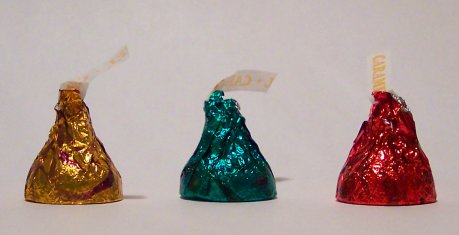 Kisspeptins are actually a group of proteins with similar structure, and are products of the KiSS-1 gene. This gene was discovered in 1996 [Lee et al., 2006] when scientists were searching for a gene that prevents cancer from spreading. This groundbreaking work took place in research labs in the town of Hershey, Pennsylvania, the location also famous for the Hershey's chocolate factory. Since Hershey's most popular product is a chocolate confectionary called a Hershey's Kiss (photo, right), the discoverers' of the gene named it KiSS-1 after this chocolate. However, the nomenclature also has a scientific grounding as the inclusion of SS in the name also indicates that the gene is a suppressor sequence, i.e. it prevents some biological process from occurring (such as cancer spreading). Kisspeptin was first given the name metastin, because it was thought to play a role in tumor metastasis, but later named kisspeptin after its gene pecursor. The receptor for kisspeptin in the brain was identified only recently and was given the rather less whimsical name GPR54 (G-Protein Coupled Receptor 54).
Kisspeptins are actually a group of proteins with similar structure, and are products of the KiSS-1 gene. This gene was discovered in 1996 [Lee et al., 2006] when scientists were searching for a gene that prevents cancer from spreading. This groundbreaking work took place in research labs in the town of Hershey, Pennsylvania, the location also famous for the Hershey's chocolate factory. Since Hershey's most popular product is a chocolate confectionary called a Hershey's Kiss (photo, right), the discoverers' of the gene named it KiSS-1 after this chocolate. However, the nomenclature also has a scientific grounding as the inclusion of SS in the name also indicates that the gene is a suppressor sequence, i.e. it prevents some biological process from occurring (such as cancer spreading). Kisspeptin was first given the name metastin, because it was thought to play a role in tumor metastasis, but later named kisspeptin after its gene pecursor. The receptor for kisspeptin in the brain was identified only recently and was given the rather less whimsical name GPR54 (G-Protein Coupled Receptor 54).
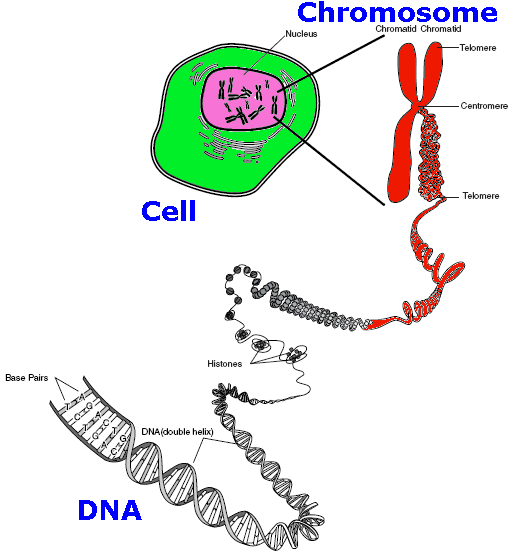
The KiSS-1 gene is found on the long-arm of chromosome 1. The protein it makes is a peptide containing 145 amino-acids, which are then cleaved into smaller, 54-amino-acid chunks. These may also be further truncated down to 14, 13 or even 10 amino-acids fragments with carboxylic acid terminations. These N-terminally truncated peptides are known as the family of kisspeptins. Kisspeptin-10 is shown below.
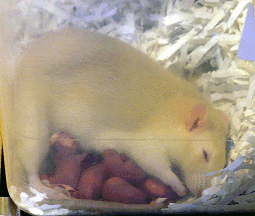 A single injection of kisspeptin in animals has been found to stimulate a huge increase in the secretion of gonadotropins (hormones that stimulate the production of testosterone in men and estradiol in women). Repeated injections into immature rats has been shown to advance the age of puberty.
A single injection of kisspeptin in animals has been found to stimulate a huge increase in the secretion of gonadotropins (hormones that stimulate the production of testosterone in men and estradiol in women). Repeated injections into immature rats has been shown to advance the age of puberty.
Very recently, a group of Japanese scientists delivered an antibody directed against kisspeptin into the brain of female rats. This stopped the rats' reproductive cycle demonstrating that inhibiting the effect of kisspeptin, even after puberty, still blocks reproductive function. Therefore, as well as being vital to initiate puberty, kisspeptin is necessary for reproductive function to continue later in life. Later, Spanish scientists discovered that administering kisspeptin in food-restricted rats still stimulated the release of gonadotropins. This is a remarkable discovery, since normally when a mammal is facing starvation its reproductive system becomes dormant to conserve the body's stored food supply. Kisspeptin injections over-ride this defence mechanism, and can kick-start normally dormant reproductive systems.
It has also been discovered that kisspeptin plays a role in seasonal-breeding animals. Many mammals only become fertile during the annual breeding season, and this is controlled by the duration of daylight per day. During short winter days, these anmials have a reduced amount of kisspeptin in certain parts of the brain, and sexual activity is switched off (or greatly reduced). But in the long summer days, kisspeptin amounts increase, stimulating the animals to breed. Artificially injecting animals (such as ewes) with kisspeptin during the winter months causes ovulation even in the non-breeding season [Dhilo 2008]. This has implications for farmers, who may soon be able to choose when their livestock reproduce rather than be restricted by the natural annual cycle.
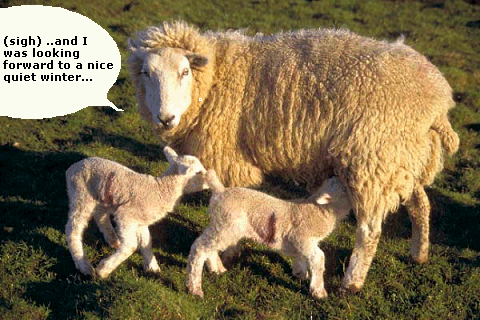
Because of its link with the KiSS-1 gene, kisspeptin has been suggested as a possible treatment for some forms of cancer. In particular, when breast and prostate cancers develop, they are nurtured by the sex hormones oestrogen and testosterone. If the production of these hormones could be switched off the tumours should shrivel and die. One way to do this might be to block the kisspeptin-receptor in the brain. Scientists are now actively looking for molecules that can block this receptor.
 Kisspeptin's role in switching-on sexual hormones could be vital in controlling the timing of puberty when this goes wrong. There are a number of conditions where children that reach puberty much too early (five or six years old) could possibly be treated by simply taking pills containing kispeptin derivatives. Conversely, for young people in which puberty does not begin as normal in their teenage years, it may be possible to administer kisspeptin to kick-start the process.
Kisspeptin's role in switching-on sexual hormones could be vital in controlling the timing of puberty when this goes wrong. There are a number of conditions where children that reach puberty much too early (five or six years old) could possibly be treated by simply taking pills containing kispeptin derivatives. Conversely, for young people in which puberty does not begin as normal in their teenage years, it may be possible to administer kisspeptin to kick-start the process.
It has recently been found that kisspeptin can restart the female reproductive system in women who have stopped ovulating due to an imbalance in their sex hormones. Kisspeptin is therefore a potential basis for a new infertility treatment.
![]()